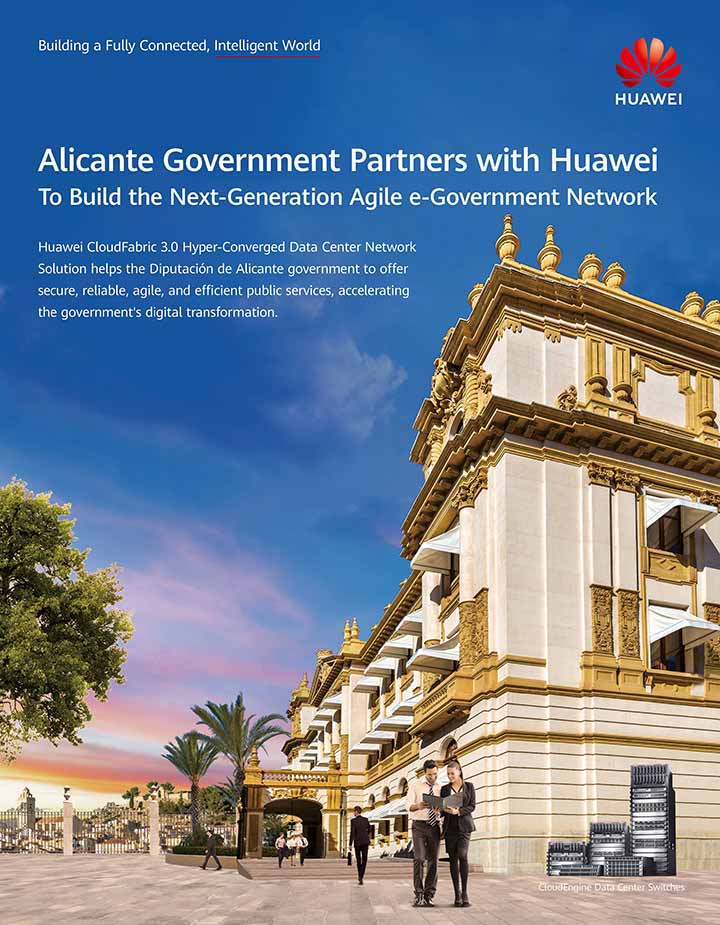The Alicante Government in Spain Builds an Agile E-Government Network with Huawei
Productos, soluciones and servicios para los negocios
Alicante, a province located in southeast Spain, is known for its stunning tourist resorts, all-year-round sunshine, and golden beaches. Little wonder that it's so popular with tourists. Indeed, every year, in addition to its two million permanent residents, over eight and a half million visitors — tourists, freelancers, and remote workers — flock to the province, straining the local government's services.
The Diputación de Alicante is the public body that's responsible for providing all such services, with approximately 2000 employees spread throughout 45 branches. It also provides information infrastructure and technologies for Alicante's 121 city halls, as well as Internet services for residents and tourists alike, including tourism and social apps, remote desktop and conferencing, accounting, and ticket management.
Alicante's e-government network had been in use for 10 years and this legacy system was beginning to show the strain, with management and Operations and Maintenance (O&M) pain points beginning to build.
Legacy network devices only provided single GE bandwidth, far less than that required by bandwidth-intensive services like video and conferencing. Compounding matters, traditional Command-Line Interface (CLI) management was leading to spiraling O&M costs, with a workforce unfamiliar with all commands across devices.
With Information Technology (IT) systems becoming increasingly commonplace across the board, the provincial government decided to focus on acquiring the latest technologies to improve social administration and public services. The existing network was unable to support next-level services, with some new functions simply non-configurable on older devices, meaning that growing demands for cloud applications and Voice over Internet Protocol (VoIP) services would remain unmet until something changed.
Although the government's data center services were increasing exponentially, access to services was not clearly separated or distinguished. When a fault occurred, multiple departments — network, security, service, IT, and more — needed to collaborate to locate the fault, resulting in inefficient O&M and an overly complex process.
Today, to keep up with ever-changing service requirements, networks need to be upgraded frequently. On Alicante's e-government live networks, operations were performed manually, relying on the accumulated expertise of its staff. While a single change could take weeks to make, the approach was also prone to human error, frequently causing network faults and service interruptions.

Huawei's CloudFabric 3.0 Hyper-Converged Data Center Network (DCN) Solution helped the Alicante government build an efficient and unified next generation e-government DCN. This future-proofed network, based on Software-Defined Networking (SDN) architecture, uses iMaster NCE-Fabric — Huawei's data center autonomous driving Network Management System (NMS) — to implement End to End (E2E) management, configuration, and O&M automation.
Flexible Server Access
New network architecture supports flexible 10 GE, 25 GE, 40 GE, and 100 GE access for servers and enables on-demand scaling.
Automated Deployment in Minutes
Minute-Level Fault Locating
Powered by real-time network status visibility and intelligent O&M, faults can be detected and located within minutes. In addition, the solution provides three-level rollback —network-wide, tenant-level, and service-level rollback — improving O&M efficiency by 90%.
Huawei's CloudFabric 3.0 Hyper-Converged DCN Solution has helped Alicante significantly improve the convenience of its services for end-users as well as O&M efficiency. It has also enabled flexibility and efficiency in city halls across the region. Unsurprising, then, that both residents and visitors have enjoyed the results.
Huawei will continue to provide rapid response and rich expertise, working with the Alicante government to build high-performance, highly reliable, and agile next generation e-government networks.